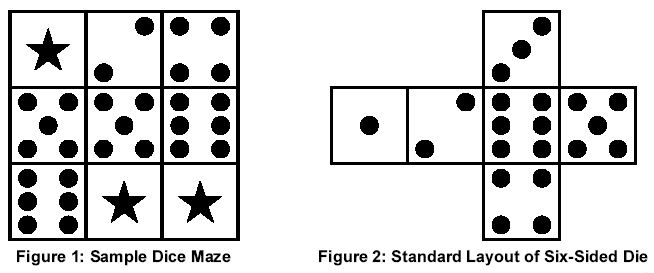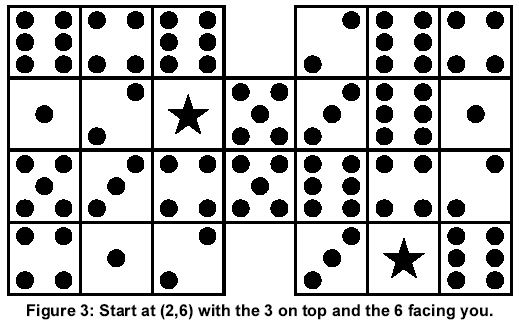poj 1872 A Dicey Problem WA的代码,望各位指教!!!
| Time Limit: 1000MS | Memory Limit: 65536K | |
| Total Submissions: 832 | Accepted: 278 |
Description

To move through the maze you must tip the die over on an edge to land on an adjacent square, effecting horizontal or vertical movement from one square to another. However, you can only move onto a square that contains the same number as the number displayed on the top of the die before the move, or onto a "wild" square which contains a star. Movement onto a wild square is always allowed regardless of the number currently displayed on the top of the die. The goal of the maze is to move the die off the starting square and to then find a way back to that same square.
For example, at the beginning of the maze there are two possible moves. Since the 5 is on top of the die, it is possible to move down one square, and since the square to the left of the starting position is wild it is also possible to move left. If the first move chosen is to move down, this brings the 6 to the top of the die and moves are now possible both to the right and down. If the first move chosen is instead to the left, this brings the 3 to the top of the die and no further moves are possible.
If we consider maze locations as ordered pairs of row and column numbers (row, column) with row indexes starting at 1 for the top row and increasing toward the bottom, and column indexes starting at 1 for the left column and increasing to the right, the solution to this simple example maze can be specified as: (1,2), (2,2), (2,3), (3,3), (3,2), (3,1), (2,1), (1,1), (1,2). A bit more challenging example maze is shown in Figure 3.
The goal of this problem is to write a program to solve dice mazes. The input file will contain several mazes for which the program should search for solutions. Each maze will have either a unique solution or no solution at all. That is, each maze in the input may or may not have a solution, but those with a solution are guaranteed to have only one unique solution. For each input maze, either a solution or a message indicating no solution is possible will be sent to the output.

Input
Output
Sample Input
DICEMAZE1
3 3 1 2 5 1
-1 2 4
5 5 6
6 -1 -1
DICEMAZE2
4 7 2 6 3 6
6 4 6 0 2 6 4
1 2 -1 5 3 6 1
5 3 4 5 6 4 2
4 1 2 0 3 -1 6
DICEMAZE3
3 3 1 1 2 4
2 2 3
4 5 6
-1 -1 -1
END
Sample Output
DICEMAZE1
(1,2),(2,2),(2,3),(3,3),(3,2),(3,1),(2,1),(1,1),(1,2)
DICEMAZE2
(2,6),(2,5),(2,4),(2,3),(2,2),(3,2),(4,2),(4,1),(3,1),
(2,1),(2,2),(2,3),(2,4),(2,5),(1,5),(1,6),(1,7),(2,7),
(3,7),(4,7),(4,6),(3,6),(2,6)
DICEMAZE3
No Solution Possible
Source
#include<stdio.h>
#include<string.h>
#include<ctype.h> int r,c,map[15][15],vis[15][15][7][7],die[][6]={{7,4,2,5,3,7},{3,7,6,1,7,4},{5,1,7,7,6,2},{2,6,7,7,1,5},{4,7,1,6,7,3},{7,3,5,2,4,7}};//die[i][j]表示i+1为top j+1为face时骰子左边的点数
int sr,sc;//face[7]={0,6,5,4,3,2,1},
int dx[4]={0,0,1,-1},dy[4]={1,-1,0,0},w,deep;
char name[25]; struct point
{
int i,j,fi,fj;
}s[3000]; int bound(int y,int x)
{
if(x>=1&&x<=c&&y>=1&&y<=r)
return 1;
else
return 0;
} int dfs(struct point a,int facenum,int topnum)//r是行c是列
{
int i,j;
if(a.i==sr&&a.j==sc&&deep>0)
return 1;
deep++;
for(i=0;i<4;i++)
{
if(bound(a.i+dy[i],a.j+dx[i])&&(map[a.i+dy[i]][ a.j+dx[i]]==-1||map[a.i+dy[i]][a.j+dx[i]]==topnum))
{
if(i<2)
{
if(i==0)
{
if(!vis[a.i+1][a.j][topnum][7-facenum])//表示向下滚(i增大)
{
vis[a.i+1][a.j][topnum][7-facenum]=1;
s[w].i=a.i+1;
s[w].j=a.j;//s[w].fi=a.i;s[w].fj=a.j;
w++;
if(dfs(s[w-1],topnum,7-facenum))
{
// printf("(%d,%d)",a.i,a.j);
return 1;
}
else w--;
}
}
else
{
if(!vis[a.i-1][a.j][7-topnum][facenum])//向上滚(也就是i减小的方向)
{
vis[a.i-1][a.j][7-topnum][facenum]=1;
s[w].i=a.i-1;
s[w].j=a.j;//s[w].fi=a.i;s[w].fj=a.j;
w++;
if(dfs(s[w-1],7-topnum,facenum))
{
// printf("(%d,%d)",a.i,a.j);
return 1;
}
else w--;
}
}
}
else
{
if(i==2)
{
if(!vis[a.i][a.j+1][facenum][die[topnum-1][facenum-1]])//向右滚
{
vis[a.i][a.j+1][facenum][die[topnum-1][facenum-1]]=1;
s[w].i=a.i;
s[w].j=a.j+1;//s[w].fi=a.i;s[w].fj=a.j;
w++;
if(dfs(s[w-1],facenum,die[topnum-1][facenum-1]))
{
// printf("(%d,%d)",a.i,a.j);
return 1;
}
else w--;
}
}
else
{
if(!vis[a.i][a.j-1][facenum][7-die[topnum-1][facenum-1]])//向左滚
{
vis[a.i][a.j-1][facenum][7-die[topnum-1][facenum-1]]=1;
s[w].i=a.i;
s[w].j=a.j-1;//s[w].fi=a.i;s[w].fj=a.j;
w++;
if(dfs(s[w-1],facenum,7-die[topnum-1][facenum-1]))
{
// printf("(%d,%d)",a.i,a.j);
return 1;
}
else w--;
}
}
}
}
}
return 0;
} int scan()//优化输入的
{
char c;
int ret;
int sig=0;
while(isspace(c=getchar()))
;
if(c=='-')
{
sig=1;
c=getchar();
}
ret=c-'0';
while((c=getchar())>='0'&& c<='9')
ret=ret*10+c-'0';
return sig?-ret:ret;
}
int main()
{
int i,j,k,ft,ff;
while(1)
{
gets(name);
if(strcmp(name,"END")==0)
break;
//scanf("%d%d%d%d%d%d",&r,&c,&sr,&sc,&ft,&ff);
r=scan();
c=scan();
sr=scan();
sc=scan();
ft=scan();
ff=scan();
for(i=1;i<=r;i++)
for(j=1;j<=c;j++)
{
//scanf("%d",&map[i][j]);
map[i][j]=scan();
}
//getchar();
memset(s,0,sizeof(s));
memset(vis,0,sizeof(vis));
s[0].i=sr;
s[0].j=sc;
w=1;
puts(name);
deep=0;
if(dfs(s[0],ff,ft))
{
printf(" ");
for(i=0;i<w-1;i++)
{
printf("(%d,%d),",s[i].i,s[i].j);
if((i+1)%9==0)
{
printf("\n ");
}
}
printf("(%d,%d)\n",s[i].i,s[i].j);
}
else printf(" No Solution Possible\n");
}
return 0;
}
poj 1872 A Dicey Problem WA的代码,望各位指教!!!的更多相关文章
- POJ 2826 An Easy Problem? 判断线段相交
POJ 2826 An Easy Problem?! -- 思路来自kuangbin博客 下面三种情况比较特殊,特别是第三种 G++怎么交都是WA,同样的代码C++A了 #include <io ...
- UVA 810 - A Dicey Problem(BFS)
UVA 810 - A Dicey Problem 题目链接 题意:一个骰子,给你顶面和前面.在一个起点,每次能移动到周围4格,为-1,或顶面和该位置数字一样,那么问题来了,骰子能不能走一圈回到原地, ...
- UVA-810 A Dicey Problem (BFS)
题目大意:滚骰子游戏,骰子的上面的点数跟方格中的数相同时或格子中的数是-1时能把格子滚过去,找一条从起点滚到起点的路径. 题目大意:简单BFS,状态转移时细心一些即可. 代码如下; # include ...
- POJ.3468 A Simple Problem with Integers(线段树 区间更新 区间查询)
POJ.3468 A Simple Problem with Integers(线段树 区间更新 区间查询) 题意分析 注意一下懒惰标记,数据部分和更新时的数字都要是long long ,别的没什么大 ...
- POJ 3468 A Simple Problem with Integers 【线段树,区间更新】
题意:你有N个整数,A1,A2,-,一个.你须要处理两种类型的操作.一种类型的操作是加入了一些给定的数字,每一个数字在一个给定的时间间隔. 还有一种是在给定的时间间隔要求数量的总和. 难点:主要是la ...
- POJ 3468.A Simple Problem with Integers-线段树(成段增减、区间查询求和)
POJ 3468.A Simple Problem with Integers 这个题就是成段的增减以及区间查询求和操作. 代码: #include<iostream> #include& ...
- poj 3468 A Simple Problem with Integers 【线段树-成段更新】
题目:id=3468" target="_blank">poj 3468 A Simple Problem with Integers 题意:给出n个数.两种操作 ...
- POJ 1152 An Easy Problem! (取模运算性质)
题目链接:POJ 1152 An Easy Problem! 题意:求一个N进制的数R.保证R能被(N-1)整除时最小的N. 第一反应是暴力.N的大小0到62.发现当中将N进制话成10进制时,数据会溢 ...
- poj1872A Dicey Problem
Home Problems Status Contest 284:28:39 307:00:00 Overview Problem Status Rank A B C D E F G H ...
随机推荐
- Android 应用开发推荐书单
本文由 伯乐在线 - zerob13 翻译自 fromdev.欢迎加入Android小组.转载请参见文章末尾处的要求. Android 已经成为了世界上最受欢迎的操作系统之一.成千上万的智能手机和平板 ...
- JDK 安装环境配置(ubuntu)
在Ubuntu 上安装jdk,先去官网下载相对应的tar包 网址:(这是jdk1.8) http://www.oracle.com/technetwork/java/javase/downloads/ ...
- boost之program_options库,解析命令行参数、读取配置文件
一.命令行解析 tprogram_options解析命令行参数示例代码: #include <iostream> using namespace std; #include <boo ...
- Codeforces Round #199 (Div. 2) B. Xenia and Spies
B. Xenia and Spies time limit per test 2 seconds memory limit per test 256 megabytes input standard ...
- Android Gradle Plugin指南(六)——高级构建定制
原文地址:http://tools.android.com/tech-docs/new-build-system/user-guide#TOC-Advanced-Build-Customization ...
- [linux]linux命令学习-netstat
linux非常多服务都与网络相关.当服务调不通或者是启动port被占用,或者是又是被防火墙挡住的时候,就须要查询网络相关的问题,netstat命令之前仅仅会用一两个參数这里.好好学习一番. 经常使用的 ...
- 基于W5500+Yeelink的远程灯光控制设计
概述 工具:物联网云平台Yeelink DHT11温湿度传感器 W5500EVB 编译环境:Keil4 目的:通过以太网实时监控远程某个位置的温度和湿度 在W5500EVB端连接LED灯.通过W ...
- Android 它们的定义View视图
创建一个新视图将满足我们独特UI需求. 本文介绍的发展将指南针罗盘接口使用UI,通过继承View定义自己的视图类工具,为了深入了解自己的自定义视图. 实现效果图: 源码: 布局文件activity_m ...
- Swift - 经纬度位置坐标与真实地理位置相互转化
通过CoreLocation类,得到的定位信息都是以经度和纬度等表示的地理信息,通过CLGeocoder类可以将其反编码成一个地址.反之,也可根据一个地址获取经纬度. 1,通过经纬度获取地址 1 2 ...
- ASP.NET中IsPostBack详解(转载)
1.IsPostBack介绍Page.IsPostBack是一个标志:当前请求是否第一次打开. 调用方法为:Page.IsPostBack或者IsPostBack或者this.IsPostBack或者 ...
